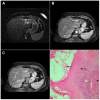Imaging Spectrum of Intrahepatic Mass-Forming Cholangiocarcinoma and Its Mimickers: How to Differentiate Them Using MRI
- PMID: 35200560
- PMCID: PMC8870737
- DOI: 10.3390/curroncol29020061
Imaging Spectrum of Intrahepatic Mass-Forming Cholangiocarcinoma and Its Mimickers: How to Differentiate Them Using MRI
Abstract
Intrahepatic cholangiocarcinoma (ICC) is the second most common primary hepatic malignancy, with mass-forming growth pattern being the most common. The typical imaging appearance of mass-forming ICC (mICC) consists of irregular ring enhancement in the arterial phase followed by the progressive central enhancement on portal venous and delayed phases. However, atypical imaging presentation in the form of hypervascular mICC might also be seen, which can be attributed to distinct pathological characteristics. Ancillary imaging features such as lobular shape, capsular retraction, segmental biliary dilatation, and vascular encasement favor the diagnosis of mICC. Nevertheless, these radiological findings may also be present in certain benign conditions such as focal confluent fibrosis, sclerosing hemangioma, organizing hepatic abscess, or the pseudosolid form of hydatid disease. In addition, a few malignant lesions including primary liver lymphoma, hemangioendothelioma, solitary hypovascular liver metastases, and atypical forms of hepatocellular carcinoma (HCC), such as scirrhous HCC, infiltrative HCC, and poorly differentiated HCC, may also pose a diagnostic dilemma by simulating mICC in imaging studies. Diffusion-weighted imaging and the use of hepatobiliary contrast agents might be helpful for differential diagnosis in certain cases. The aim of this manuscript is to provide a comprehensive overview of mICC imaging features and to describe useful tips for differential diagnosis with its potential mimickers.
Keywords: magnetic resonance imaging; mass-forming cholangiocarcinoma; mimickers.
Conflict of interest statement
The authors declare no conflict of interest.
Figures






















Similar articles
-
Differentiation of mass-forming intrahepatic cholangiocarcinoma from poorly differentiated hepatocellular carcinoma: based on the multivariate analysis of contrast-enhanced computed tomography findings.Abdom Radiol (NY). 2016 May;41(5):978-89. doi: 10.1007/s00261-015-0629-z. Abdom Radiol (NY). 2016. PMID: 27193795
-
Distinguishing intrahepatic mass-forming biliary carcinomas from hepatocellular carcinoma by computed tomography and magnetic resonance imaging using the Bayesian method: a bi-center study.Eur Radiol. 2020 Nov;30(11):5992-6002. doi: 10.1007/s00330-020-06972-w. Epub 2020 Jun 4. Eur Radiol. 2020. PMID: 32500195
-
Intrahepatic mass-forming cholangiocarcinoma and solitary hypovascular liver metastases: is the differential diagnosis using diffusion-weighted MRI possible?Acta Radiol. 2017 Dec;58(12):1417-1426. doi: 10.1177/0284185117695666. Epub 2017 Mar 28. Acta Radiol. 2017. PMID: 28350257
-
Atypical Appearance of Hepatocellular Carcinoma and Its Mimickers: How to Solve Challenging Cases Using Gadoxetic Acid-Enhanced Liver Magnetic Resonance Imaging.Korean J Radiol. 2019 Jul;20(7):1019-1041. doi: 10.3348/kjr.2018.0636. Korean J Radiol. 2019. PMID: 31270973 Free PMC article. Review.
-
Cholangiocarcinoma - Part 2, Tumoral and Nontumoral Mimics and Imaging Features Helpful in Differentiation.Curr Probl Diagn Radiol. 2022 May-Jun;51(3):362-374. doi: 10.1067/j.cpradiol.2021.02.005. Epub 2021 Feb 7. Curr Probl Diagn Radiol. 2022. PMID: 33627221 Review.
Cited by
-
Tumour burden score combined with albumin-to-alkaline phosphatase ratio predicts prognosis in patients with intrahepatic cholangiocarcinoma.J Cell Mol Med. 2024 Jul;28(13):e18530. doi: 10.1111/jcmm.18530. J Cell Mol Med. 2024. PMID: 38961673 Free PMC article.
-
Cholangiocarcinoma: The Current Status of Surgical Options including Liver Transplantation.Cancers (Basel). 2024 May 21;16(11):1946. doi: 10.3390/cancers16111946. Cancers (Basel). 2024. PMID: 38893067 Free PMC article. Review.
-
A comparative study of clinicopathological and imaging features of HBV-negative and HBV-positive intrahepatic cholangiocarcinoma patients with different pathologic differentiation degrees.Sci Rep. 2023 Nov 13;13(1):19726. doi: 10.1038/s41598-023-47108-6. Sci Rep. 2023. PMID: 37957323 Free PMC article.
-
Standardizing the reporting of cholangiocarcinoma: the society of abdominal radiology disease focused panel on cholangiocarinoma lexicon.Abdom Radiol (NY). 2025 Jul;50(7):2858-2867. doi: 10.1007/s00261-024-04769-9. Epub 2025 Jan 7. Abdom Radiol (NY). 2025. PMID: 39775025 Free PMC article. Review.
-
Added Value of Ultrasound-Based Multimodal Imaging to Diagnose Hepatic Sclerosed Hemangioma before Biopsy and Resection.Diagnostics (Basel). 2022 Nov 16;12(11):2818. doi: 10.3390/diagnostics12112818. Diagnostics (Basel). 2022. PMID: 36428878 Free PMC article.
References
Publication types
MeSH terms
LinkOut - more resources
Full Text Sources
Medical

